The constellations best seen in May are Canes Venatici, Centaurus, Coma Berenices, Corvus, Crux, Musca and Virgo. Canes Venatici and Coma Berenices are northern constellations, while Centaurus, Virgo, Corvus, Crux and Musca lie south of the celestial equator. Virgo and Centaurus are the 2nd and 9th largest constellations in the sky, while Crux is the smallest.
May is the best time of year to observe the many interesting deep sky objects located in these constellations. The most popular telescope targets include the Virgo Cluster and Coma Cluster of galaxies, the Whirlpool Galaxy (M51), the Sunflower Galaxy (M63), the Black Eye Galaxy (M64), the Sombrero Galaxy (M104), the Antennae Galaxies, Omega Centauri, Centaurus A and the Jewel Box Cluster.
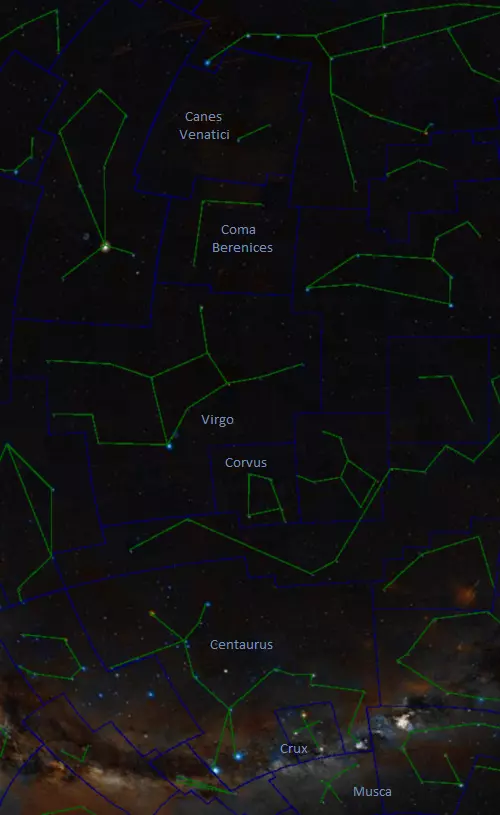
May constellations, image: Wikisky
The northern constellations Canes Venatici and Coma Berenices are easy to find because they are located under the handle of the Big Dipper, one of the most recognizable asterisms in the sky. However, neither constellation is particularly conspicuous because the only star brighter than magnitude 4.00 in this region is Cor Caroli, the brightest star in Canes Venatici. With a combined visual magnitude of 2.9, the binary star marks one of the vertices of the Great Diamond, a prominent spring asterism also formed by Arcturus in Boötes, Spica in Virgo and Denebola in Leo.
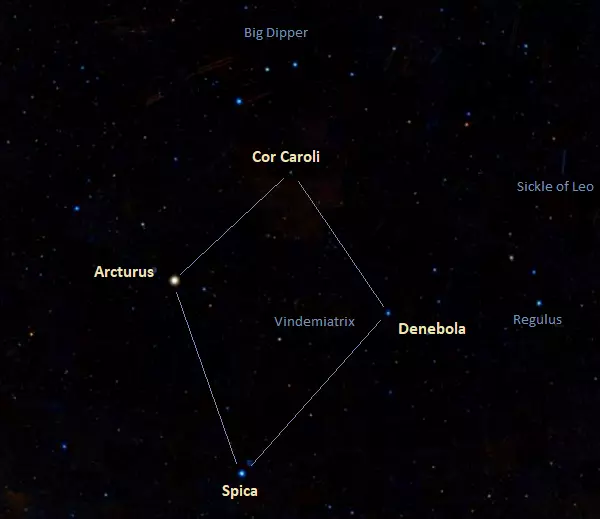
The Great Diamond, image: Wikisky
Canes Venatici is also home to La Superba (Y Canum Venaticorum), one of the reddest stars in the sky. The red giant is a carbon star classified as a semi-regular variable. Its visual magnitude varies from 4.86 to 7.32 over a period of about 160 days.
Both Canes Venatici and Coma Berenices are rich in deep sky objects and each constellation contains several famous galaxies.
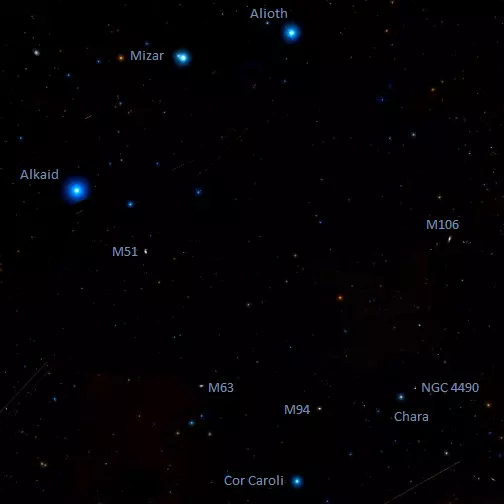
Canes Venatici galaxies, appearing south of the Big Dipper’s handle, image: Wikisky
Canes Venatici hosts five Messier objects: the Whirlpool Galaxy (M51), Sunflower Galaxy (M63), Cat’s Eye Galaxy (M94), the spiral galaxy Messier 106, and the bright, large globular cluster Messier 3. In addition to these, the constellation is home to the Whale Galaxy (NGC 4631), the Hockey Stick Galaxies (NGC 4656 and NGC 4657), the Cocoon Galaxy (NGC 4490), and a number of other stunning deep sky objects.
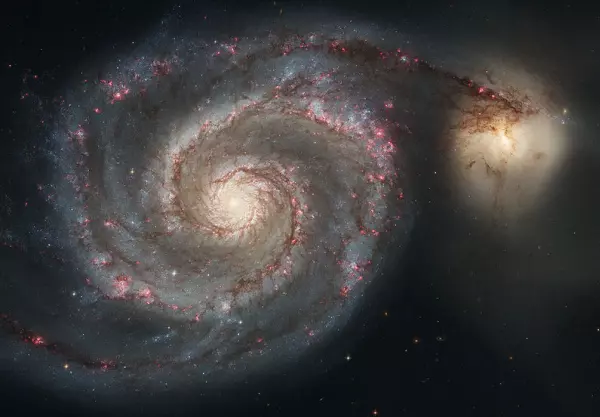
Whirlpool Galaxy (Messier 51), photo: NASA, ESA, S. Beckwith (STScI), and The Hubble Heritage Team STScI, AURA)
Coma Berenices is slightly smaller than its neighbour, but just as abundant in deep sky objects. Home to the Coma Cluster of galaxies, as well as to the northern portion of the Virgo Cluster, the constellation is particularly rich in galaxies.
The supergiant elliptical galaxies NGC 4874 (Coma A) and NGC 4889 (Coma B) dominate the central region of the Coma Cluster. The cluster contains at least 10,000 galaxies, mostly elliptical. The brightest spiral galaxy in the cluster is NGC 4921 and other notable members include the Mice Galaxies (NGC 4676), an interacting pair of spiral galaxies, and Dragonfly 44, an ultra diffuse galaxy believed to consist almost entirely of dark matter.
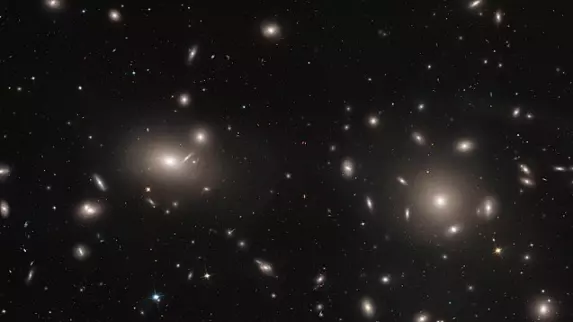
This image, from the NASA/ESA Hubble Space Telescope’s Advanced Camera for Surveys (ACS), reveals thousands of globular clusters lying at the core of a galaxy cluster. It was created by a Hubble survey that drew on data from three of the telescope’s separate observing programmes to explore the centre of the Coma Cluster, a huge gathering of over 1,000 galaxies, about 320 million light-years away, all bound together by gravity. Astronomers spotted over 22,000 globular clusters, some of which had formed a bridge connecting a pair of well-known interacting galaxies (NGC 4889 and NGC 4874). A globular cluster is a spherical group of stars that usually orbits a galaxy as a self-contained satellite. However, the globular clusters studied here are of a different type, intracluster globular clusters. Specifically, these are globular clusters that are not bound to an individual galaxy, but to a galaxy cluster — in this case, Coma. While globular clusters orbiting our Milky Way reveal themselves as sparkling spherical assemblies of densely packed stars, at the distance of the Coma Cluster, they only appear as tiny dots of light, even to Hubble’s advanced vision. However, a characteristic feature of globular clusters is their colour; since the stars in any given cluster all formed at around the same time and from the same “stuff”, they usually have a consistent colour. In this way, the astronomers were able to identify the clusters — and rule out background galaxies lying in the same region of sky — by analysing their colour and size, painting a beautiful family portrait of Coma and its clusters. With the help of the identified globular clusters astronomers can map the distribution of matter and — even more important — of dark matter in the Coma Cluster. The Coma Cluster was one of the first places where observed gravitational anomalies indicated the existence of dark matter. Image: NASA, ESA, J. Mack, and J. Madrid et al.
Coma Berenices contains a total of eight Messier objects. The most famous one, the Black Eye Galaxy (M64), is a spiral galaxy known for its bright nucleus surrounded by a dark band of dust. It is sometimes also known as the Sleeping Beauty or Evil Eye galaxy. Other Messier objects in the constellation are the globular cluster Messier 53 and the Virgo Cluster members Messier 85, Messier 88, Messier 91, Messier 98, Messier 99 (Coma Pinwheel), and the grand design spiral galaxy Messier 100.
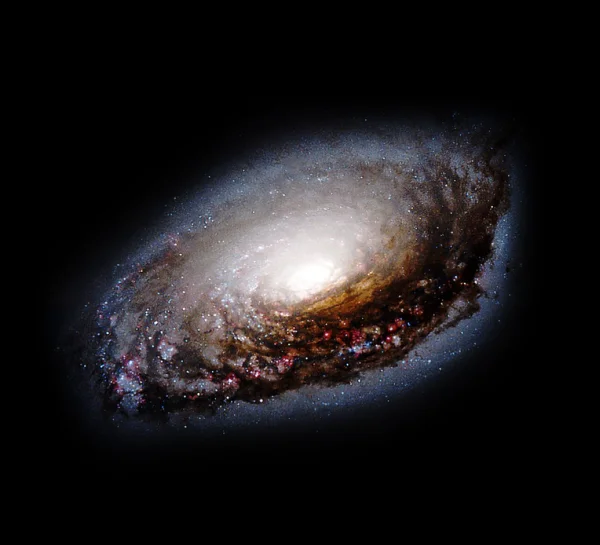
Black Eye Galaxy (M64) is an isolated spiral galaxy 17 million ly away in the constellation of Coma Berenices – A dark band of absorbing dust in front of the galaxy’s bright nucleus gave rise to its name – Outer ring-like structure, inner non-barred ring/spiral with its spiral arms fairly tightly wound – Two counter-rotating disks in the interstellar medium suggests a merger with a gas-rich satellite galaxy in a retrograde orbit. Image: Pablo Carlos Budassi (CC BY-SA 4.0)
Coma Berenices also contains the Coma Star Cluster, a large open star cluster, the famous edge-on spiral galaxy known as the Needle Galaxy (NGC 4565), and the spiral galaxies NGC 4314, NGC 4414 and NGC 4651, the last of which is known as the Umbrella Galaxy.
Occupying an area of 1294 square degrees south of Coma Berenices, Virgo is smaller only than Hydra. The constellation is visible from most inhabited places on Earth and its brightest star, Spica, is the 16th brightest star in the sky, with a visual magnitude of 0.98.
Spica, Alpha Virginis, is a binary system consisting of a blue giant and a very close companion. It is one of the nearest massive binary systems to Earth. The star marks one of the vertices of the Spring Triangle (the other two being Arcturus and Regulus or Denebola) and it is also part of the Great Diamond, along with Cor Caroli, Regulus and Arcturus.
Two other stars in Virgo are brighter than magnitude 3.00: Porrima (Gamma Virginis), a binary system consisting of almost identical white main sequence stars, and Vindemiatrix (Epsilon Virginis), a yellow giant star used to find the center of the Virgo Cluster of galaxies, which is located about halfway between Vindemiatrix and Denebola in Leo.
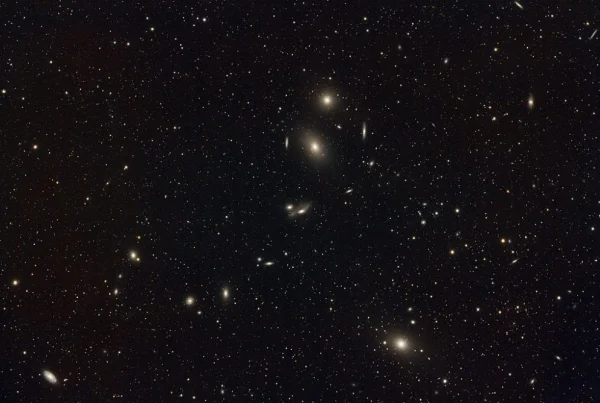
Virgo Cluster, image: Wikimedia Commons/Kees Scherer
Virgo contains a total of 11 Messier objects. The famous Sombrero Galaxy (M104), a magnificent unbarred spiral galaxy located near the border with Corvus, is the only one that isn’t a member of the Virgo Cluster. The remaining ones are: Messier 49, Messier 58, Messier 59, Messier 60, Messier 61, Messier 84, Messier 86, Messier 87, Messier 89, and Messier 90. Messier 87, also known as Virgo A, is the largest galaxy in the cluster. The supergiant elliptical galaxy is also one of the most massive galaxies in the Local Supercluster. The brightest member of the Virgo Cluster is the elliptical galaxy Messier 49.
Messier 84 and Messier 86 are part of Markarian’s Chain, a majestic stretch of galaxies near the center of the cluster that also includes the Eyes Galaxies, a famous interacting pair catalogued as NGC 4438 and NGC 4435.
Located between Virgo and Hydra, the constellation Corvus, the Raven, occupies an area of only 184 square degrees, which makes it one of the smaller constellations, only the 70th in size. Its four brightest stars – Gienah (Gamma Corvi, mag. 2.58), Kraz (Beta Corvi, mag. 2.65), Algorab (Delta Corvi, mag. 2.94) and Minkar (Epsilon Corvi, mag. 3.02) – form a quadrilateral asterism not far from Spica that makes Corvus easy to identify even if the stars themselves aren’t particularly bright. The asterism is known as the Sail or Spica’s Spanker.
Corvus is visible from any location south of the equator and from northern latitudes south of 60°N. Unlike its northern neighbours, the constellation does not have any Messier objects, but is home to several interesting deep sky objects that can be seen in amateur telescopes. The Antennae Galaxies, a famous pair of interacting galaxies catalogued as NGC 4038 and NGC 4039, are members of the NGC 4038 Group, a group of galaxies found in Corvus and the neighbouring Crater. The Ringtail Galaxy (NGC 4027), a peculiar barred spiral galaxy, is another well-known member of the group. Corvus also contains NGC 4361, a large planetary nebula located near the centre of the constellation.
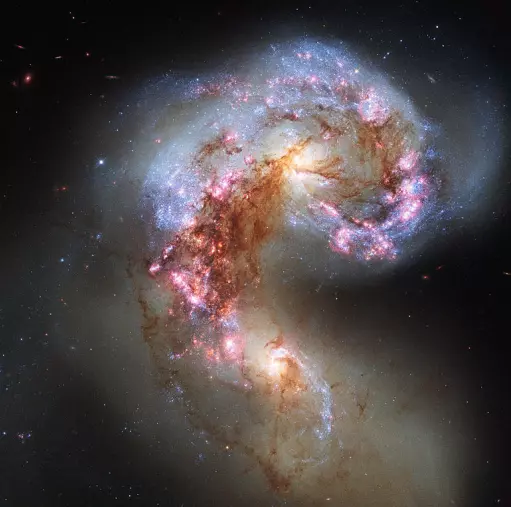
This image of the Antennae Galaxies shows obvious signs of chaos. Clouds of gas are seen in bright pink and red, surrounding the bright flashes of blue star-forming regions — some of which are partially obscured by dark patches of dust. The rate of star formation is so high that the Antennae Galaxies are said to be in a state of starburst, a period in which all of the gas within the galaxies is being used to form stars. This cannot last forever and neither can the separate galaxies; eventually the nuclei will coalesce, and the galaxies will begin their retirement together as one large elliptical galaxy. Image: ESA/Hubble & NASA
Centaurus and Crux are among the best known southern constellations, but they are invisible to observers north of latitudes 25°N and 20°N respectively.
Occupying an area of 1060 degrees, Centaurus is the ninth largest constellation in the sky. It contains 10 stars brighter than magnitude 3.00, including Alpha Centauri, the third brightest star in the sky, and Beta Centauri (Hadar), the 11th brightest star. Alpha and Beta Centauri are known as the Southern Pointers, as they point toward Crux, the Southern Cross, which is used in navigation to find true south. Centaurus has a total of 281 stars brighter than magnitude 6.5, more than any other constellation.
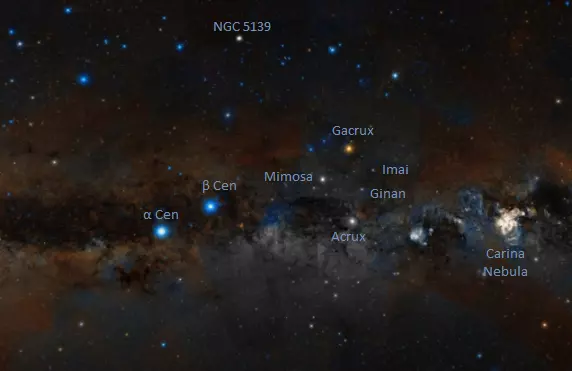
Alpha and Beta Centauri and the Southern Cross, image: Wikisky
Alpha Centauri is a multiple star system consisting of two Sun-like stars and a small, faint red dwarf. The binary star Alpha Centauri AB has an apparent magnitude of -0.27, which makes it fainter only than Sirius and Canopus. Proxima Centauri (Alpha Centauri C), the third component of the Alpha Centauri system, is the nearest star to the Sun. The red dwarf is located at a distance of only 4.24 light years.
Not far from Hadar lies one of the largest stars known. V766 Centauri (HR 5171) is a triple star system consisting of a contact binary, a star sharing an envelope of material with a smaller star, and a third component. The larger component of the contact binary system is believed to be either a red supergiant or a yellow hypergiant with an estimated diameter 1,300 to 1,500 times that of the Sun. The smaller component is about one third the size of the primary. The third component in the system is a class B supergiant, a highly luminous star, but considerably fainter than the primary component.
Centaurus is also home to the brightest globular cluster in the sky, Omega Centauri. Suspected to be the core remnant of a former dwarf galaxy, Omega Centauri is also the largest and most massive globular cluster in the Milky Way, containing about 10 million stars within a diameter of 150 light years. With an apparent magnitude of 3.9 and an apparent size of 36’.3, it is easily visible without binoculars. When seen from a location with no light pollution, the cluster appears almost as large as the full Moon. It lies at a distance of 15,800 light years from Earth.
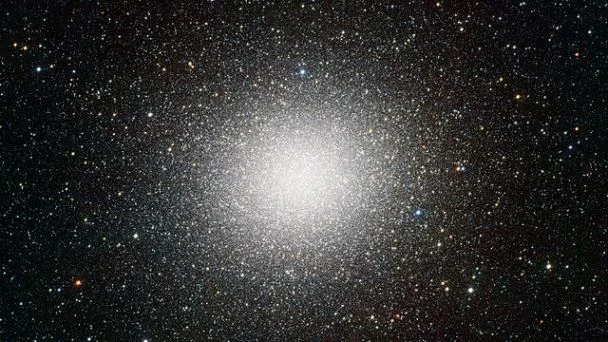
The second released VST image may be the best portrait of the globular star cluster Omega Centauri ever made. Omega Centauri, in the constellation of Centaurus (The Centaur), is the largest globular cluster in the sky, but the very wide field of view of VST and its powerful camera OmegaCAM can encompass even the faint outer regions of this spectacular object. This view includes about 300,000 stars. The data were processed using the VST-Tube system developed by A. Grado and collaborators at the INAF-Capodimonte Observatory. Image: ESO/INAF-VST/OmegaCAM. Acknowledgement: A. Grado/INAF-Capodimonte Observatory
Centaurus also contains a couple of open clusters visible to the unaided eye in good conditions: NGC 3766 (mag. 5.3), which contains several dozen fast-rotating pulsating B-type variable stars, and NGC 5460 (mag. 5.6), a slightly older cluster located about 2 degrees east-southeast of the star Zeta Centauri.
The Blue Planetary nebula (NGC 3918), also known as the Southerner, is the brightest planetary nebula in this region of the sky. With an apparent magnitude of 8.5, it can be observed in a small telescope.
Centaurus A (NGC 5128), the fifth brightest galaxy in the sky and one of the closest radio galaxies to Earth, is a popular astrophotography target due to its large apparent size and high surface brightness. It is located about 4 degrees north of Omega Centauri and has an apparent magnitude of 6.84.
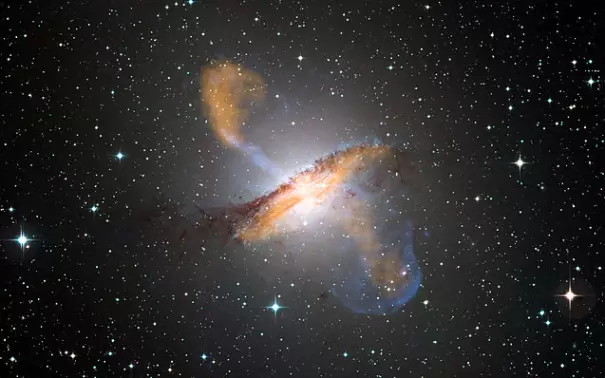
Colour composite image of Centaurus A, revealing the lobes and jets emanating from the active galaxy’s central black hole. This is a composite of images obtained with three instruments, operating at very different wavelengths. The 870-micron submillimetre data, from LABOCA on APEX, are shown in orange. X-ray data from the Chandra X-ray Observatory are shown in blue. Visible light data from the Wide Field Imager (WFI) on the MPG/ESO 2.2 m telescope located at La Silla, Chile, show the stars and the galaxy’s characteristic dust lane is close to “true colour”. Image: ESO/WFI (Optical); MPIfR/ESO/APEX/A.Weiss et al. (Submillimetre); NASA/CXC/CfA/R.Kraft et al. (X-ray)
Centaurus is also home to the Centaurus Cluster (A3526), which contains hundreds of galaxies located at an approximate distance of 170 million light years from Earth. The elliptical galaxy NGC 4696 is the brightest member. NGC 4622, an unbarred spiral galaxy with a ring structure, nicknamed the Backward Galaxy, is another notable member of the cluster.
Other galaxies in the constellation include the barred spiral galaxy NGC 4945, the polar-ring lenticular galaxy NGC 4650A, the irregular galaxy NGC 5253, the colliding pair NGC 5090 and NGC 5091, and NGC 5291, a system of colliding galaxies surrounded by a collisional ring.
Crux, the smallest of all constellations, occupies an area of only 68.4 square degrees. With the four main stars brighter than magnitude 2.8 and forming a prominent cross-shaped asterism, Crux is probably the best known constellation in the southern sky. The asterism, known as the Southern Cross, has carried cultural significance in the southern hemisphere since ancient times. It appears on the flags of Australia, New Zealand, Papua New Guinea, Samoa, and a number of regions and territories in the countries of South America.
Acrux (Alpha Crucis), Mimosa (Beta Crucis) and Gacrux (Gamma Crucis), the brightest stars in Crux, are the 13th, 21st and 25th brightest stars in the sky respectively. Alpha and Gamma Crucis are used in navigation to find south: an imaginary line drawn from Gacrux to Acrux leads to a point near the southern celestial pole.
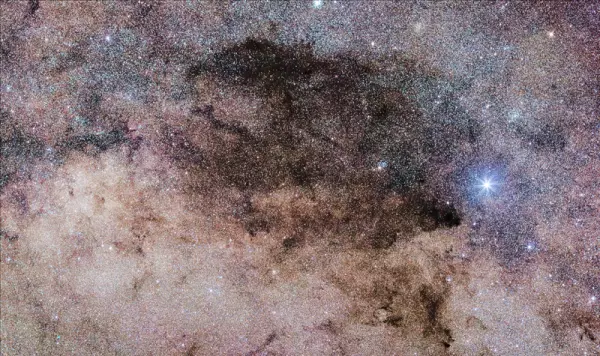
Coalsack Nebula, image: Wikimedia Commons/Naskies (CC BY-SA 3.0)
Crux contains two notable deep sky objects. One of these, the Jewel Box Cluster (or Kappa Crucis Cluster, catalogued as NGC 4755) is an open star cluster with an apparent magnitude of 4.2. The cluster is visible to the unaided eye, appearing as a blurry star near Beta Crucis in good conditions. It is one of the youngest open clusters in our galaxy. Most of its brightest stars are blue supergiants, including the brightest member, the spectroscopic binary star Kappa Crucis.
Crux is also home to the Coalsack Nebula, a large dark nebula that covers an area of 7 by 5 degrees, overlapping into the neighbouring constellations Centaurus and Musca.
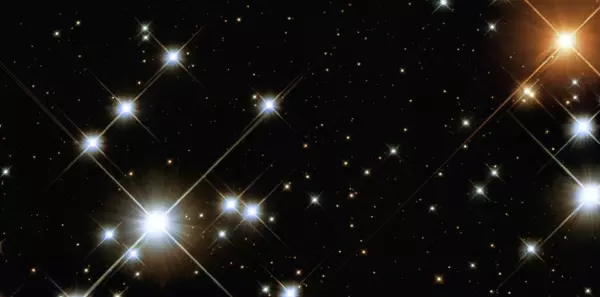
This image is a “close-up” view from the NASA/ESA Hubble Space Telescope of NGC 4755, or the Jewel Box Cluster. Several very bright, pale blue super-giant stars (eg. κ Crucis on the left, HD 111934 on the lower right and HIP 62913 in the middle right), a solitary ruby-red super-giant (HIP 62918 – upper right) and a variety of other brilliantly coloured stars are visible in the image, as well as many much fainter ones, often with intriguing colours. The huge variety in brightness exists because the brighter stars are 15 to 20 times the mass of the Sun, while the dim points are less than half the mass of the Sun. This is the first image of an open galactic cluster with imaging extending from the far ultraviolet to the near-infra-red. Image: NASA/ESA and Jesús Maíz Apellániz (Instituto de Astrofísica de Andalucía, Spain), 2009
Musca, the Fly, is also among the smallest constellations, occupying an area of 138 square degrees. It is invisible to all northern observers except those living in equatorial latitudes. Its brightest star, Alpha Muscae, has a visual magnitude of 2.69 and is the only star in the constellation brighter than magnitude 3.00.
Musca contains several interesting deep sky objects, among them the Engraved Hourglass Nebula (MyCn 18), a young planetary nebula named for its shape, the Spiral Planetary Nebula (NGC 5189), whose S-shape vaguely resembles that of a spiral galaxy in a telescope, the globular clusters NGC 4833 and NGC 4372, and the Dark Doodad Nebula, a dark nebula stretching across almost three degrees of arc in the vicinity of NGC 4372, just south of the better known Coalsack Nebula.
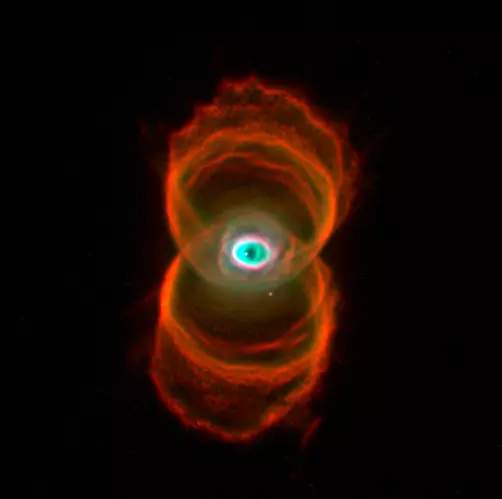
The Engraved Hourglass Nebula (MyCn18) is a young planetary nebula located about 8,000 light years away. This artificially colorized image was taken with the Wide Field and Planetary Camera 2 aboard NASA’s Hubble Space Telescope. Image: NASA, R. Sahai, J. Trauger (JPL), and The WFPC2 Science Team
The table below shows the latitudes between which the May constellations are visible.
| Constellation | Northern latitude | Southern latitude |
| Canes Venatici | 90° | 40° |
| Centaurus | 25° | 90° |
| Coma Berenices | 90° | 70° |
| Corvus | 60° | 90° |
| Crux | 20° | 90° |
| Musca | 10° | 90° |
| Virgo | 80° | 80° |